A Review of the Mineral Chemistry and Crystallization Conditions of Ediacaran–Cambrian A-Type Granites in the Central Subprovince of the Borborema Province, Northeastern Brazil
Abstract
1. Introduction
2. The Borborema Province Geological Background
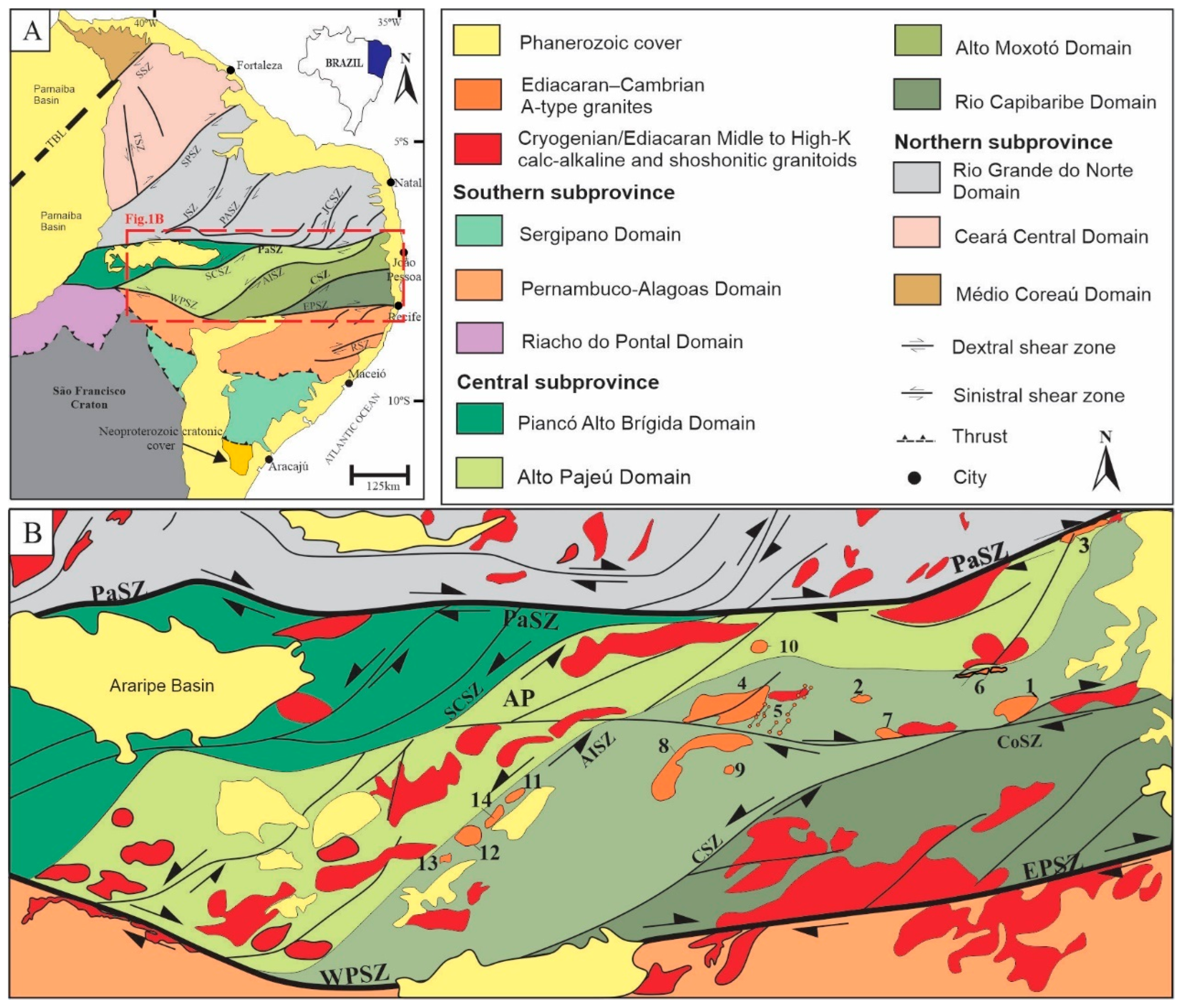
3. Geological Context of the Studied A-Type Granites
3.1. Introduction
3.2. Aroeiras Complex
3.3. Bravo Pluton
3.4. Pilõezinhos Pluton
3.5. Serra Branca Suite
3.6. Queimadas Pluton
3.7. Marinho Pluton
3.8. Prata Complex
3.9. Serra da Engabelada Pluton
3.10. Serrote Santo Antonio Pluton
3.11. Serra do Pereiro, Serra do Velho Zuza, Açude do Caroá, and Boqueirão Plutons
4. Whole-Rock Geochemistry
5. Mineral Chemistry
5.1. Amphibole
5.2. Biotite
5.3. Feldspars
5.4. Accessory Minerals
5.5. Zircon Trace Element Composition
6. Discussion
6.1. Mineralogical Characterization, Chemical Affinity, and Petrogenetic Implications
6.2. Estimation of Crystallization Parameters
6.2.1. Temperature
6.2.2. Pressure
| Plutons | PP | SBS | BP | ACP | QP | MP | BQ | |||||||
| Temperature (°C) | Min | Max | Min | Max | Min | Max | Min | Max | Min | Max | Min | Max | Min | Max |
| Blund and Holland [123] | 745 | 795 | 560 | 711 | 581 | 785 | 776 | 812 | - | - | - | - | - | - |
| Putirka [126] | 704 | 758 | 750 | 789 | 650 | 730 | 660 | 876 | 655 | 736 | 671 | 802 | 676 | 691 |
| Watson and Harrison [129] | 772 | 946 | 743 | 838 | 847 | 893 | 804 | 826 | 752 | 903 | 795 | 930 | 857 | 857 |
| Harrison and Watson [130] | 916 | 1028 | 784 | 897 | 882 | 998 | 1037 | 1080 | 757 | 980 | 865 | 997 | 982 | 982 |
| Pressure (kbar) | Min | Max | Min | Max | Min | Max | Min | Max | Min | Max | Min | Max | Min | Max |
| Mutch et al. [134] | 5.2 | 7.0 | 5.98 | 6.45 | 4.53 | 6.39 | 2.5 | 4.6 | 3.85 | 6.72 | 3.94 | 5.38 | 4.29 | 5.21 |
| Plutons | VZP | SSAP | SEP | AC | PC | PEP | ||||||||
| Temperature (°C) | Min | Max | Min | Max | Min | Max | Min | Max | Min | Max | Min | Max | ||
| Blund and Holland [123] | - | - | - | - | - | - | 733 | 809 | - | - | - | - | ||
| Putirka [126] | - | - | - | - | - | - | 698 | 740 | 657 | 769 | - | - | ||
| Watson and Harrison [129] | 755 | 895 | 844 | 844 | 810 | 810 | 687 | 790 | 804 | 916 | 790 | 878 | ||
| Watson and Harrison [130] | 790 | 986 | 875 | 875 | 860 | 860 | 804 | 1096 | 714 | 1164 | 851 | 956 | ||
| Pressure (kbar) | Min | Max | Min | Max | Min | Max | Min | Max | Min | Max | Min | Max | ||
| Mutch et al. [134] | - | - | - | - | - | - | 4.01 | 5.75 | - | - | - | - | ||
6.2.3. Oxygen Fugacity
6.3. Post-Magmatic Processes
7. Conclusions
Supplementary Materials
Author Contributions
Funding
Data Availability Statement
Acknowledgments
Conflicts of Interest
References
- Wedepohl, K.H. Chemical Composition and Fractionation of the Continental Crust. Geol. Rundsch. 1991, 80, 207–223. [Google Scholar] [CrossRef]
- Rudnick, R.L.; Gao, S. Composition of the Continental Crust. In Treatise on Geochemistry; Elsevier: Amsterdam, The Netherlands, 2003; Volume 3, pp. 1–64. [Google Scholar]
- Taylor, S.R.; McLennan, S.M. The Geochemical Evolution of the Continental Crust. Rev. Geophys. 1995, 33, 241–265. [Google Scholar] [CrossRef]
- Kemp, A.I.S.; Hawkesworth, C.J.; Foster, G.L.; Paterson, B.A.; Woodhead, J.D.; Hergt, J.M.; Gray, C.M.; Whitehouse, M.J. Magmatic and Crustal Differentiation History of Granitic Rocks from Hf-O Isotopes in Zircon. Science 2007, 315, 980–983. [Google Scholar] [CrossRef]
- Barbarin, B. A Review of the Relationships between Granitoid Types, Their Origins and Their Geodynamic Environments. Lithos 1999, 46, 605–626. [Google Scholar] [CrossRef]
- Brown, M. Granite: From Genesis to Emplacement. Bull. Geol. Soc. Am. 2013, 125, 1079–1113. [Google Scholar] [CrossRef]
- Chappell, B.W.; White, A.J.R. I- and S-Type Granites in the Lachlan Fold Belt. Earth Environ. Sci. Trans. R. Soc. Edinb. 1992, 83, 1–26. [Google Scholar] [CrossRef]
- Hawkesworth, C.J.; Kemp, A.I.S. Using Hafnium and Oxygen Isotopes in Zircons to Unravel the Record of Crustal Evolution. Chem. Geol. 2006, 226, 144–162. [Google Scholar] [CrossRef]
- Iles, K.A.; Hergt, J.M.; Woodhead, J.D.; Ickert, R.B.; Williams, I.S. Petrogenesis of Granitoids from the Lachlan Fold Belt, Southeastern Australia: The Role of Disequilibrium Melting. Gondwana Res. 2020, 79, 87–109. [Google Scholar] [CrossRef]
- Jacob, J.-B.; Moyen, J.-F.; Fiannacca, P.; Laurent, O.; Bachmann, O.; Janoušek, V.; Farina, F.; Villaros, A. Crustal Melting vs. Fractionation of Basaltic Magmas: Part 2, Attempting to Quantify Mantle and Crustal Contributions in Granitoids. Lithos 2021, 402–403, 106292. [Google Scholar] [CrossRef]
- Moyen, J.-F.; Janoušek, V.; Laurent, O.; Bachmann, O.; Jacob, J.-B.; Farina, F.; Fiannacca, P.; Villaros, A. Crustal Melting vs. Fractionation of Basaltic Magmas: Part 1, Granites and Paradigms. Lithos 2021, 402–403, 106291. [Google Scholar] [CrossRef]
- Vigneresse, J.L. A New Paradigm for Granite Generation. Earth Environ. Sci. Trans. R. Soc. Edinb. 2004, 95, 11–22. [Google Scholar] [CrossRef]
- Sawyer, E.W.; Cesare, B.; Brown, M. When the Continental Crust Melts. Elements 2011, 7, 229–234. [Google Scholar] [CrossRef]
- Hawkesworth, C.; Cawood, P.; Kemp, T.; Storey, C.; Dhuime, B. A Matter of Preservation. Science 2009, 323, 49–50. [Google Scholar] [CrossRef]
- Cawood, P.A.; Chowdhury, P.; Mulder, J.A.; Hawkesworth, C.J.; Capitanio, F.A.; Gunawardana, P.M.; Nebel, O. Secular Evolution of Continents and the Earth System. Rev. Geophys. 2022, 60, e2022RG000789. [Google Scholar] [CrossRef]
- Laurent, O.; Martin, H.; Moyen, J.F.; Doucelance, R. The Diversity and Evolution of Late-Archean Granitoids: Evidence for the Onset of “Modern-Style” Plate Tectonics between 3.0 and 2.5 Ga. Lithos 2014, 205, 208–235. [Google Scholar] [CrossRef]
- Condie, K.C.; Pisarevsky, S.A.; Puetz, S.J.; Roberts, N.M.W.; Spencer, C.J. A-Type Granites in Space and Time: Relationship to the Supercontinent Cycle and Mantle Events. Earth Planet Sci. Lett. 2023, 610, 118125. [Google Scholar] [CrossRef]
- Bonin, B.; Janoušek, V.; Moyen, J.-F. Chemical Variation, Modal Composition and Classification of Granitoids. Geol. Soc. Lond. Spec. Publ. 2020, 491, 9–51. [Google Scholar] [CrossRef]
- Frost, B.R.; Barnes, C.G.; Collins, W.J.; Arculus, R.J.; Ellis, D.J.; Frost, C.D. A Geochemical Classification for Granitic Rocks. J. Petrol. 2001, 42, 2033–2048. [Google Scholar] [CrossRef]
- Gao, P.; Zheng, Y.; Zhao, Z. Experimental Melts from Crustal Rocks: A Lithochemical Constraint on Granite Petrogenesis. Lithos 2016, 266–267, 133–157. [Google Scholar] [CrossRef]
- Loiselle, M.C.; Wones, D.R. Characteristics and Origin of Anorogenic Granites. Geol. Soc. Am. Abstr. Program 1979, 11, 468. [Google Scholar]
- Frost, C.D.; Frost, B.R. On Ferroan (A-Type) Granitoids: Their Compositional Variability and Modes of Origin. J. Petrol. 2011, 52, 39–53. [Google Scholar] [CrossRef]
- Bonin, B. A-Type Granites and Related Rocks: Evolution of a Concept, Problems and Prospects. Lithos 2007, 97, 1–29. [Google Scholar] [CrossRef]
- Johansson, Å. A Tentative Model for the Origin of A-Type Granitoids. Minerals 2023, 13, 236. [Google Scholar] [CrossRef]
- Collins, W.J.; Huang, H.-Q.; Bowden, P.; Kemp, A.I.S. Repeated S–I–A-Type Granite Trilogy in the Lachlan Orogen and Geochemical Contrasts with A-Type Granites in Nigeria: Implications for Petrogenesis and Tectonic Discrimination. Geol. Soc. Lond. Spec. Publ. 2020, 491, 53–76. [Google Scholar] [CrossRef]
- Collins, W.J.; Beams, S.D.; White, A.J.R.; Chappell, B.W. Nature and Origin of A-Type Granites with Particular Reference to Southeastern Australia. Contrib. Miner. Petrol. 1982, 80, 189–200. [Google Scholar] [CrossRef]
- Creaser, R.A.; Price, R.C.; Wormald, R.J. A-Type Granites Revisited: Assessment of a Residual-Source Model. Geology 1991, 19, 163–166. [Google Scholar] [CrossRef]
- Eby, G.N. The A-Type Granitoids: A Review of Their Occurrence and Chemical Characteristics and Speculations on Their Petrogenesis. Lithos 1990, 26, 115–134. [Google Scholar] [CrossRef]
- Dall’Agnol, R.; de Oliveira, D.C. Oxidized, Magnetite-Series, Rapakivi-Type Granites of Carajás, Brazil: Implications for Classification and Petrogenesis of A-Type Granites. Lithos 2007, 93, 215–233. [Google Scholar] [CrossRef]
- King, P.L.; White, A.J.R.; Chappell, B.W.; Allen, C.M. Characterization and Origin of Aluminous A-Type Granites from the Lachlan Fold Belt, Southeastern Australia. J. Petrol. 1997, 38, 371–391. [Google Scholar] [CrossRef]
- Sylvester, P.J. Post-Collisional Strongly Peraluminous Granites; Elsevier: Amsterdam, The Netherlands, 1998; Volume 45. [Google Scholar]
- Ferré, E.C.; Caby, R.; Peucat, J.J.; Capdevila, R.; Monié, P. Pan-African, Post-Collisional, Ferro-Potassic Granite and Quartz–Monzonite Plutons of Eastern Nigeria. Lithos 1998, 45, 255–279. [Google Scholar] [CrossRef]
- Goodenough, K.M.; Lusty, P.A.J.; Roberts, N.M.W.; Key, R.M.; Garba, A. Post-Collisional Pan-African Granitoids and Rare Metal Pegmatites in Western Nigeria: Age, Petrogenesis, and the ‘Pegmatite Conundrum’. Lithos 2014, 200–201, 22–34. [Google Scholar] [CrossRef]
- Eby, G.N. Chemical Subdivision of the A-Type Granitoids:Petrogenetic and Tectonic Implications. Geology 1992, 20, 641. [Google Scholar] [CrossRef]
- Amorim, J.V.A.d.; de Pinho Guimarães, I.; Farias, D.J.S.; Lima, J.V.d.; Santos, L.; Ribeiro, V.B.; Brainer, C. Late-Neoproterozoic Ferroan Granitoids of the Transversal Subprovince, Borborema Province, NE Brazil: Petrogenesis and Geodynamic Implications. Int. Geol. Rev. 2019, 61, 1745–1767. [Google Scholar] [CrossRef]
- Almeida, C.N.; Guimarães, I.P.; Silva Filho, A.F. A-Type Post-Collisional Granites in the Borborema Province—NE Brazil: The Queimadas Pluton. Gondwana Res. 2002, 5, 667–681. [Google Scholar] [CrossRef]
- Guimarães, I.P.; Silva Filho, A.F.; Melo, S.C.; Macambira, M.B. Petrogenesis of A-Type Granitoids from the Alto Moxoto and Alto Pajeu Terranes of the Borborema Province, Ne Brazil: Constraints from Geochemistry and Isotopic Composition. Gondwana Res. 2005, 8, 347–362. [Google Scholar] [CrossRef]
- Lima, J.V.; Guimarães, I.d.P.; Santos, L.; Amorim, J.V.A.; Farias, D.J.S. Geochemical and Isotopic Characterization of the Granitic Magmatism along the Remígio—Pocinhos Shear Zone, Borborema Province, NE Brazil. J. S. Am. Earth Sci. 2017, 75, 116–133. [Google Scholar] [CrossRef]
- Lages, G.d.A.; Marinho, M.d.S.; Nascimento, M.A.L.d.; Medeiros, V.C.d.; Dantas, E.L. Geocronologia e Aspectos Estruturais e Petrológicos Do Pluton Bravo, Domínio Central Da Província Borborema, Nordeste Do Brasil: Um Granito Transalcalino Precoce No Estágio Pós-Colisional Da Orogênese Brasiliana. Braz. J. Geol. 2016, 46, 41–61. [Google Scholar] [CrossRef][Green Version]
- Hollanda, M.H.B.M.; Archanjo, C.J.; Souza, L.C.; Armstrong, R.; Vasconcelos, P.M. Cambrian Mafic to Felsic Magmatism and Its Connections with Transcurrent Shear Zones of the Borborema Province (NE Brazil): Implications for the Late Assembly of the West Gondwana. Precambrian Res. 2010, 178, 1–14. [Google Scholar] [CrossRef]
- Van Schmus, W.R.; de Brito Neves, B.B.; Hackspacher, P.; Babinski, M. U-Pb and Sm-Nd Geochronologic Studies of the Eastern Borborema Province, Northeastern Brazil: Initial Conclusions. J. S. Am. Earth Sci. 1995, 8, 267–288. [Google Scholar] [CrossRef]
- Caxito, F.d.A.; Santos, L.C.M.d.L.; Ganade, C.E.; Bendaoud, A.; Fettous, E.-H.; Bouyo, M.H. Toward an Integrated Model of Geological Evolution for NE Brazil-NW Africa: The Borborema Province and Its Connections to the Trans-Saharan (Benino-Nigerian and Tuareg Shields) and Central African Orogens. Braz. J. Geol. 2020, 50. [Google Scholar] [CrossRef]
- Van Schmus, W.R.; Oliveira, E.P.; Silva Filho, A.F.; Toteu, S.F.; Penaye, J.; Guimarães, I.P. Proterozoic Links between the Borborema Province, NE Brazil, and the Central African Fold Belt. Geol. Soc. Lond. Spec. Publ. 2008, 294, 69–99. [Google Scholar] [CrossRef]
- Toteu, S.F.; Van Schmus, W.R.; Penaye, J.; Michard, A. New U–Pb and Sm–Nd Data from North-Central Cameroon and Its Bearing on the Pre-Pan African History of Central Africa. Precambrian Res. 2001, 108, 45–73. [Google Scholar] [CrossRef]
- Van Schmus, W.R.; Kozuch, M.; Brito Neves, B.B. Precambrian History of the Zona Transversal of the Borborema Province, NE Brazil: Insights from Sm–Nd and U–Pb Geochronology. J S. Am. Earth Sci. 2011, 31, 227–252. [Google Scholar] [CrossRef]
- Ferreira, A.C.D.; Dantas, E.L.; Fuck, R.A.; Nedel, I.M. Arc Accretion and Crustal Reworking from Late Archean to Neoproterozoic in Northeast Brazil. Sci. Rep. 2020, 10, 7855. [Google Scholar] [CrossRef] [PubMed]
- Lira Santos, L.C.M.; Lages, G.A.; Caxito, F.A.; Dantas, E.L.; Cawood, P.A.; Lima, H.M.; da Cruz Lima, F.J. Isotopic and Geochemical Constraints for a Paleoproterozoic Accretionary Orogen in the Borborema Province, NE Brazil: Implications for Reconstructing Nuna/Columbia. Geosci. Front. 2022, 13, 101167. [Google Scholar] [CrossRef]
- Dantas, E.L.; Hackspacker, P.C.; Van Schmus, W.R.V.; Brito Neves, B.B. Archean Accretion in the Sao Jose Do Campestre Massif, Borborema Province, Northeast Brazil. Rev. Bras. Geociências 1998, 28, 221–228. [Google Scholar] [CrossRef]
- Guimarães, I.P.; Van Schmus, W.R.; Brito Neves, B.B.; Bretas Bittar, S.M.; Silva Filho, A.F.; Armstrong, R. U–Pb Zircon Ages of Orthogneisses and Supracrustal Rocks of the Cariris Velhos Belt: Onset of Neoproterozoic Rifting in the Borborema Province, NE Brazil. Precambrian Res. 2012, 192–195, 52–77. [Google Scholar] [CrossRef]
- Neves, S.P. Constraints from Zircon Geochronology on the Tectonic Evolution of the Borborema Province (NE Brazil): Widespread Intracontinental Neoproterozoic Reworking of a Paleoproterozoic Accretionary Orogen. J. S. Am. Earth Sci. 2015, 58, 150–164. [Google Scholar] [CrossRef]
- Hollanda, M.H.B.M.; Archanjo, C.J.; Bautista, J.R.; Souza, L.C. Detrital Zircon Ages and Nd Isotope Compositions of the Seridó and Lavras Da Mangabeira Basins (Borborema Province, NE Brazil): Evidence for Exhumation and Recycling Associated with a Major Shift in Sedimentary Provenance. Precambrian Res. 2015, 258, 186–207. [Google Scholar] [CrossRef]
- Oliveira, E.P.; McNaughton, N.J.; Windley, B.F.; Carvalho, M.J.; Nascimento, R.S. Detrital Zircon U–Pb Geochronology and Whole-Rock Nd-Isotope Constraints on Sediment Provenance in the Neoproterozoic Sergipano Orogen, Brazil: From Early Passive Margins to Late Foreland Basins. Tectonophysics 2015, 662, 183–194. [Google Scholar] [CrossRef]
- Araujo, C.E.G.; Cordani, U.G.; Basei, M.A.S.; Castro, N.A.; Sato, K.; Sproesser, W.M. U–Pb Detrital Zircon Provenance of Metasedimentary Rocks from the Ceará Central and Médio Coreaú Domains, Borborema Province, NE-Brazil: Tectonic Implications for a Long-Lived Neoproterozoic Active Continental Margin. Precambrian Res. 2012, 206–207, 36–51. [Google Scholar] [CrossRef]
- Santos, T.J.S.; Fetter, A.H.; Hackspacher, P.C.; Van Schmus, W.R.; Nogueira Neto, J.A. Neoproterozoic Tectonic and Magmatic Episodes in the NW Sector of Borborema Province, NE Brazil, during Assembly of Western Gondwana. J. S. Am. Earth Sci. 2008, 25, 271–284. [Google Scholar] [CrossRef]
- Sial, A.N.; Ferreira, V.P. Magma Associations in Ediacaran Granitoids of the Cachoeirinha–Salgueiro and Alto Pajeú Terranes, Northeastern Brazil: Forty Years of Studies. J. S. Am. Earth Sci. 2016, 68, 113–133. [Google Scholar] [CrossRef]
- Oliveira, E.P.; Bueno, J.F.; McNaughton, N.J.; Silva Filho, A.F.; Nascimento, R.S.; Donatti-Filho, J.P. Age, Composition, and Source of Continental Arc- and Syn-Collision Granites of the Neoproterozoic Sergipano Belt, Southern Borborema Province, Brazil. J. S. Am. Earth Sci. 2015, 58, 257–280. [Google Scholar] [CrossRef]
- Nascimento, M.A.L.; Galindo, A.C.; Medeiros, V.C. Ediacaran to Cambrian Magmatic Suites in the Rio Grande Do Norte Domain, Extreme Northeastern Borborema Province (NE of Brazil): Current Knowledge. J. S. Am. Earth Sci. 2015, 58, 281–299. [Google Scholar] [CrossRef]
- Guimarães, I.P.; Silva Filho, A.F.; Almeida, C.N.; Van Schmus, W.R.; Araújo, J.M.M.; Melo, S.C.; Melo, E.B. Brasiliano (Pan-African) Granitic Magmatism in the Pajeú-Paraíba Belt, Northeast Brazil: An Isotopic and Geochronological Approach. Precambrian Res. 2004, 135, 23–53. [Google Scholar] [CrossRef]
- Silva Filho, A.F.; Guimarães, I.d.P.; Santos, L.; Armstrong, R.; Van Schmus, W.R. Geochemistry, U–Pb Geochronology, Sm–Nd and O Isotopes of ca. 50 Ma Long Ediacaran High-K Syn-Collisional Magmatism in the Pernambuco Alagoas Domain, Borborema Province, NE Brazil. J. S. Am. Earth Sci. 2016, 68, 134–154. [Google Scholar] [CrossRef]
- Ferreira, V.P.; Silva, T.R.d.; Lima, M.M.C.d.; Sial, A.N.; Silva Filho, A.F.; Neves, C.H.F.S.; Tchouankoue, J.P.; Lima, S.S. Tracing a Neoproterozoic Subduction to Collision Magmatism in the Eastern Pernambuco–Alagoas Domain, Northeastern Brazil. J. S. Am. Earth Sci. 2023, 128, 104457. [Google Scholar] [CrossRef]
- Neves, S.P.; Tommasi, A.; Vauchez, A.; Carrino, T.A. The Borborema Strike-Slip Shear Zone System (NE Brazil): Large-Scale Intracontinental Strain Localization in a Heterogeneous Plate. Lithosphere 2021, 2021, 6407232. [Google Scholar] [CrossRef]
- Caby, R. Precambrian Terranes of Benin-Nigeria and Northeast Brazil and the Late Proterozoic South Atlantic Fit; Terranes in the Circum-Atlantic Paleozoic Orogens: Boulder, CO, USA, 1989; pp. 145–158. [Google Scholar]
- Vauchez, A.; Neves, S.P.; Caby, R.; Corsini, M.; Egydio-Silva, M.; Arthaud, M.; Amaro, V. The Borborema Shear Zone System, NE Brazil. J. S. Am. Earth Sci. 1995, 8, 247–266. [Google Scholar] [CrossRef]
- Araujo, C.E.G.; Weinberg, R.F.; Caxito, F.A.; Lopes, L.B.L.; Tesser, L.R.; Costa, I.S. Decratonization by Rifting Enables Orogenic Reworking and Transcurrent Dispersal of Old Terranes in NE Brazil. Sci. Rep. 2021, 11, 5719. [Google Scholar] [CrossRef]
- Archanjo, C.J.; Hollanda, M.H.B.M.; Rodrigues, S.W.O.; Brito Neves, B.B.B.; Armstrong, R. Fabrics of Pre- and Syntectonic Granite Plutons and Chronology of Shear Zones in the Eastern Borborema Province, NE Brazil. J. Struct. Geol. 2008, 30, 310–326. [Google Scholar] [CrossRef]
- Santos, L.C.M.d.L.; Dantas, E.L.; Cawood, P.A.; Lages, G.d.A.; Lima, H.M.; dos Santos, E.J.; Caxito, F.A. Early to Late Neoproterozoic Subduction-Accretion Episodes in the Cariris Velhos Belt of the Borborema Province, Brazil: Insights from Isotope and Whole-Rock Geochemical Data of Supracrustal and Granitic Rocks. J. S. Am. Earth Sci. 2019, 96, 102384. [Google Scholar] [CrossRef]
- Santos, L.C.M.d.L.; Dantas, E.L.; Cawood, P.A.; Lages, G.d.A.; Lima, H.M.; dos Santos, E.J. The Cariris Velhos Tectonic Event in Northeast Brazil. J. S. Am. Earth Sci. 2010, 29, 61–76. [Google Scholar] [CrossRef]
- Lira Santos, L.C.M.; Dantas, E.L.; Cawood, P.A.; Lages, G.d.A.; Lima, H.M.; Santos, E.J. Accretion Tectonics in Western Gondwana Deduced From Sm-Nd Isotope Mapping of Terranes in the Borborema Province, NE Brazil. Tectonics 2018, 37, 2727–2743. [Google Scholar] [CrossRef]
- Santos, L.C.M.D.L.; de Oliveira, R.G.; Lages, G.d.A.; Dantas, E.L.; Caxito, F.; Cawood, P.A.; Fuck, R.A.; Lima, H.M.; Santos, G.L.; Neto, J.F.d.A. Evidence for Neoproterozoic Terrane Accretion in the Central Borborema Province, West Gondwana Deduced by Isotopic and Geophysical Data Compilation. Int. Geol. Rev. 2022, 64, 1574–1593. [Google Scholar] [CrossRef]
- Brito Neves, B.B.; Santos, E.J.d.; Fuck, R.A.; Santos, L.C.M.L. A Preserved Early Ediacaran Magmatic Arc at the Northernmost Portion of the Transversal Zone Central Subprovince of the Borborema Province, Northeastern South America. Braz. J. Geol. 2016, 46, 491–508. [Google Scholar] [CrossRef]
- Neves, S.P. Proterozoic History of the Borborema Province (NE Brazil): Correlations with Neighboring Cratons and Pan-African Belts and Implications for the Evolution of Western Gondwana. Tectonics 2003, 22. [Google Scholar] [CrossRef]
- Mariano, G.; Neves, S.P.; Siva Filho, A.F.; Guimaraes, I.P. Diorites of the High-K Calc-Alkalic Association: Geochemistry and Sm-Nd Data and Implications for the Evolution of the Borborema Province, Northeast Brazil. Int. Geol. Rev. 2001, 43, 921–929. [Google Scholar] [CrossRef]
- Lima, J.V.d.; Guimarães, I.d.P.; Neves, S.P.; Basei, M.A.S.; Silva Filho, A.F.; Brainer, C.C.G. Post-Collisional, High-Ba-Sr Teixeira Batholith Granites: Evidence for Recycling of Paleoproterozoic Crust in the Alto Pajeú Domain, Borborema Province—NE-Brazil. Lithos 2021, 404–405, 106469. [Google Scholar] [CrossRef]
- Hollanda, M.H.B.M.; Pimentel, M.M.; Jardim de Sá, E.F. Paleoproterozoic Subduction-Related Metasomatic Signatures in the Lithospheric Mantle beneath NE Brazil: Inferences from Trace Element and Sr–Nd–Pb Isotopic Compositions of Neoproterozoic High-K Igneous Rocks. J. S. Am. Earth Sci. 2003, 15, 885–900. [Google Scholar] [CrossRef]
- Neves, S.P.; Bruguier, O.; Vauchez, A.; Bosch, D.; Silva, J.M.R.d.; Mariano, G. Timing of Crust Formation, Deposition of Supracrustal Sequences, and Transamazonian and Brasiliano Metamorphism in the East Pernambuco Belt (Borborema Province, NE Brazil): Implications for Western Gondwana Assembly. Precambrian Res. 2006, 149, 197–216. [Google Scholar] [CrossRef]
- Santos, T.J.S.; Fetter, A.H.; Neto, J.A.N. Comparisons between the Northwestern Borborema Province, NE Brazil, and the Southwestern Pharusian Dahomey Belt, SW Central Africa. Geol. Soc. Lond. Spec. Publ. 2008, 294, 101–120. [Google Scholar] [CrossRef]
- Araújo, M.N.C.; Vasconcelos, P.M.; Alves da Silva, F.C.; Jardim de Sá, E.F.; Sá, J.M. 40Ar/39Ar Geochronology of Gold Mineralization in Brasiliano Strike-Slip Shear Zones in the Borborema Province, NE Brazil. J. S. Am. Earth Sci. 2005, 19, 445–460. [Google Scholar] [CrossRef]
- Araújo Neto, J.F.d.; Santos, L.C.M.d.L.; Viegas, G.; Souza, C.P.d.; Miggins, D.; Cawood, P.A. Structural and Geochronological Constraints on the Portalegre Shear Zone: Implications for Emerald Mineralization in the Borborema Province, Brazil. J. Struct. Geol. 2023, 174, 104921. [Google Scholar] [CrossRef]
- Lira Santos, L.C.M.; Dantas, E.L.; Cawood, P.A.; José dos Santos, E.; Fuck, R.A. Neoarchean Crustal Growth and Paleoproterozoic Reworking in the Borborema Province, NE Brazil: Insights from Geochemical and Isotopic Data of TTG and Metagranitic Rocks of the Alto Moxotó Terrane. J. S. Am. Earth Sci. 2017, 79, 342–363. [Google Scholar] [CrossRef]
- Santos, L.; Guimarães, I.P.; Silva Filho, A.F.; Farias, D.J.S.; Lima, J.V.; Antunes, J. V Magmatismo Ediacarano Extensional Na Província Borborema, NE Brasil: Pluton Serra Branca. Comun. Geológicas 2014, 101, 199–203. [Google Scholar]
- Miranda, A.W.A. Evolução Estrutural das zonas de Cisalhamento Dúcteis na Porção Centro-Leste do Domínio da Zona Transversal na Província Borborema. Ph.D. Thesis, Universidade do Estado do Rio de Janeiro, RiodeJaneiro, Brazil, 2010. [Google Scholar]
- Guimarães, I.P.; Silva Filho, A.F.; Lima, J.V.; Farias, D.J.S.; Amorim, J.V.A.; Silva, F.M.J. V Geocronologia U-Pb e Caracterização Geoquímica Dos Granitoides Do Pluton Marinho, Provínicia Borborema. In Proceedings of the 46° Congresso Brasileiro de Geologia Anais Proceedings, Santos, Brazil, 5 October 2012. [Google Scholar]
- Silva, J.M.R.D.; Mariano, G. Geometry and Kinematics of the Afogados Da Ingazeira Shear Zone, Northeast Brazil. Int. Geol. Rev. 2000, 42, 86–95. [Google Scholar] [CrossRef]
- Melo, E.B. de Petrologia e Geoquimica de Granitoides a Sudeste da zona de Cisalhamento Afogados da Ingazeira—PE Nordeste do Brasil. Ph.D. Thesis, Universidade Federal de Pernambuco, Recife, Brazil, 2004. [Google Scholar]
- Ishihara, S. The Magnetite-Series and Ilmenite-Series Granitic Rocks. Min. Geol. 1977, 27, 293–305. [Google Scholar]
- Pearce, J.A.; Harris, N.B.W.; Tindle, A.G. Trace Element Discrimination Diagrams for the Tectonic Interpretation of Granitic Rocks. J. Petrol. 1984, 25, 956–983. [Google Scholar] [CrossRef]
- Whalen, J.B.; Currie, K.L.; Chappell, B.W. A-Type Granites: Geochemical Characteristics, Discrimination and Petrogenesis. Contrib. Miner. Petrol. 1987, 95, 407–419. [Google Scholar] [CrossRef]
- Lima, J.V.d.; Guimaraes, I.D.P.; Santos, L.; Farias, D.J.; Antunes, J.V. Química Mineral e Condições de Cristalização de Granitos Intrudidos Ao Longo Da Zona de Cisalhamento Remígio—Pocinhos, NE Do Brasil: Plúton Pilõezinhos. Pesqui. Em Geociências 2017, 44, 123. [Google Scholar] [CrossRef][Green Version]
- Santos, L.; Guimaraes, I.P.; Farias, D.J.S.; Lima, J. V Geologia, petrografia e quimica mineral de plutons contrastantes, Serra Branca e Coxixola, ao longo da Zona de Cisalhamento Coxixola, Provicia Borborema, NE Brasil. Estud. Geológicos 2013, 23, 111–142. [Google Scholar]
- Locock, A.J. An Excel Spreadsheet to Classify Chemical Analyses of Amphiboles Following the IMA 2012 Recommendations. Comput. Geosci. 2014, 62, 1–11. [Google Scholar] [CrossRef]
- Hawthorne, F.C.; Oberti, R.; Harlow, G.E.; Maresch, W.V.; Martin, R.F.; Schumacher, J.C.; Welch, M.D. Nomenclature of the Amphibole Supergroup. Am. Miner. 2012, 97, 2031–2048. [Google Scholar] [CrossRef]
- Czamanske, G.K.; Wones, D.R. Oxidation During Magmatic Differentiation, Finnmarka Complex, Oslo Area, Norway: Part 2, The Mafic Silicates1. J. Petrol. 1973, 14, 349–380. [Google Scholar] [CrossRef]
- Foster, M.D. Interpretation of the Composition of Trioctahedral Micas. US Geol. Surv. Prof. Pap. B 1960, 354, 1–49. [Google Scholar]
- Gündüz, M.; Asan, K. MagMin_PT: An Excel-based mineral classification and geothermobarometry program for magmatic rocks. Mineral. Mag. 2023, 87, 1–9. [Google Scholar] [CrossRef]
- Speer, J.A. Micas in Igneous Rocks. In Micas; Bailey, S.W., Ed.; De Gruyter: Berlin, Germany, 1984; Volume 13, pp. 299–356. [Google Scholar]
- Nachit, H.; Razafimahefa, N.; Stussi, J.-M.; Carron, J.-P. Composition Chimique Des Biotites et Typologie Magmatique Des Granitoïdes. Comtes Rendus Hebd. De L’academie Des Sci. 1985, 301, 813–818. [Google Scholar]
- Abdel-Rahman, A.-F.M. Nature of Biotites from Alkaline, Calc-Alkaline, and Peraluminous Magmas. J. Petrol. 1994, 35, 525–541. [Google Scholar] [CrossRef]
- Deer, W.A.; Howie, R.; Zussman, J. An Introduction to the Rock—Forming Minerals, 2nd ed.; Pearson Education Limited: London, UK, 1992; pp. 1–712. [Google Scholar]
- Jochum, K.P.; Weis, U.; Stoll, B.; Kuzmin, D.; Yang, Q.; Raczek, I.; Jacob, D.E.; Stracke, A.; Birbaum, K.; Frick, D.A.; et al. Determination of Reference Values for NIST SRM 610-617 Glasses Following ISO Guidelines. Geostand. Geoanalyt. Res. 2011, 35, 397–429. [Google Scholar] [CrossRef]
- Van Achterbergh, E.; Ryan, C.G.; Jackson, S.E.; Griffin, W.L. Data Reduction Software for LA-ICP-MS. In Laser-Ablation-ICPMS in the Earth Sciences; Principles and Applications; Sylvester, P.J., Ed.; Mineralogical Association of Canada: Ottawa, ON, Canada, 2001; pp. 239–243. [Google Scholar]
- Burnham, A.D. Key Concepts in Interpreting the Concentrations of the Rare Earth Elements in Zircon. Chem. Geol. 2020, 551, 119765. [Google Scholar] [CrossRef]
- El-Bialy, M.Z.; Ali, K.A. Zircon Trace Element Geochemical Constraints on the Evolution of the Ediacaran (600–614Ma) Post-Collisional Dokhan Volcanics and Younger Granites of SE Sinai, NE Arabian-Nubian Shield. Chem. Geol. 2013, 360–361, 54–73. [Google Scholar] [CrossRef]
- Rubatto, D. Zircon Trace Element Geochemistry: Partitioning with Garnet and the Link between U-Pb Ages and Metamorphism. Chem. Geol. 2002, 184, 123–138. [Google Scholar] [CrossRef]
- Hoskin, P.W.O.; Schaltegger, U. The Composition of Zircon and Igneous and Metamorphic Petrogenesis. Rev. Miner. Geochem. 2003, 53, 27–62. [Google Scholar] [CrossRef]
- Pupin, J.P. Zircon and Granite Petrology. Contrib. Miner. Petrol. 1980, 73, 207–220. [Google Scholar] [CrossRef]
- Harley, S.L.; Kelly, N.M. Zircon Tiny but Timely. Elements 2007, 3, 13–18. [Google Scholar] [CrossRef]
- Smythe, D.J.; Brenan, J.M. Magmatic Oxygen Fugacity Estimated Using Zircon-Melt Partitioning of Cerium. Earth Planet Sci. Lett. 2016, 453, 260–266. [Google Scholar] [CrossRef]
- Valley, J.W. Oxygen Isotopes in Zircon. Rev. Miner. Geochem. 2003, 53, 343–385. [Google Scholar] [CrossRef]
- Kirkland, C.L.; Smithies, R.H.; Taylor, R.J.M.; Evans, N.; McDonald, B. Zircon Th/U Ratios in Magmatic Environs. Lithos 2015, 212–215, 397–414. [Google Scholar] [CrossRef]
- Trail, D.; Watson, E.B.; Tailby, N.D. Ce and Eu Anomalies in Zircon as Proxies for the Oxidation State of Magmas. Geochim. Cosmochim. Acta 2012, 97, 70–87. [Google Scholar] [CrossRef]
- Schiller, D.; Finger, F. Application of Ti-in-Zircon Thermometry to Granite Studies: Problems and Possible Solutions. Contrib. Miner. Petrol. 2019, 174, 51. [Google Scholar] [CrossRef] [PubMed]
- Loucks, R.R.; Henríquez, G.J.; Fiorentini, M.L. Zircon and Whole-Rock Trace Element Indicators of Magmatic Hydration State and Oxidation State Discriminate Copper Ore-Forming from Barren Arc Magmas. Econ. Geol. 2024, 119, 511–523. [Google Scholar] [CrossRef]
- Schaltegger, U. Hydrothermal Zircon. Elements 2007, 203, 183–203. [Google Scholar] [CrossRef]
- Fu, B.; Mernagh, T.P.; Kita, N.T.; Kemp, A.I.S.; Valley, J.W. Distinguishing Magmatic Zircon from Hydrothermal Zircon: A Case Study from the Gidginbung High-Sulphidation Au-Ag-(Cu) Deposit, SE Australia. Chem. Geol. 2009, 259, 131–142. [Google Scholar] [CrossRef]
- Hoskin, P.W.O. Trace-Element Composition of Hydrothermal Zircon and the Alteration of Hadean Zircon from the Jack Hills, Australia. Geochim. Cosmochim. Acta 2005, 69, 637–648. [Google Scholar] [CrossRef]
- Williams, I.S.; Claesson, S. Isotopic Evidence for the Precambrian Provenance and Caledonian Metamorphism of High Grade Paragneisses from the Seve Nappes, Scandinavian Caledonides. Contrib. Miner. Petrol. 1987, 97, 205–217. [Google Scholar] [CrossRef]
- Taylor, S.R.; McLennan, S.H. The Continental Crust: Its Composition and Evolution; Blackwell Scientific: Oxford, UK, 1985. [Google Scholar]
- Breiter, K.; Lamarão, C.N.; Borges, R.M.K.; Dall’Agnol, R. Chemical Characteristics of Zircon from A-Type Granites and Comparison to Zircon of S-Type Granites. Lithos 2014, 192–195, 208–225. [Google Scholar] [CrossRef]
- Xie, L.; Wang, R.; Chen, X.; Qiu, J.; Wang, D. Th-Rich Zircon from Peralka Line A-Type Granite: Mineralogical Features and Petrological Implications. Chin. Sci. Bull. 2005, 50, 809–817. [Google Scholar] [CrossRef]
- Santos, L. Caracterização petrológica e geoquímica dos granitoides intrudidos ao longo da zona de cisalhamento Coxixola, Província Borborema, NE Brasil: Plutons Serra Branca e Coxixola. Master’s Thesis, Universidade Federal de Pernambuco, Recife, Brazil, 2013. [Google Scholar]
- Vilalva, F.C.J.; Simonetti, A.; Vlach, S.R.F. Insights on the Origin of the Graciosa A-Type Granites and Syenites (Southern Brazil) from Zircon U-Pb Geochronology, Chemistry, and Hf and O Isotope Compositions. Lithos 2019, 340–341, 20–33. [Google Scholar] [CrossRef]
- Loucks, R.R.; Fiorentini, M.L.; Henríquez, G.J. New Magmatic Oxybarometer Using Trace Elements in Zircon. J. Petrol. 2020, 61, egaa034. [Google Scholar] [CrossRef]
- Blundy, J.D.; Holland, T.J.B. Calcic Amphibole Equilibria and a New Amphibole-Plagioclase Geothermometer. Contrib. Miner. Petrol. 1990, 104, 208–224. [Google Scholar] [CrossRef]
- Ridolfi, F.; Renzulli, A.; Puerini, M. Stability and Chemical Equilibrium of Amphibole in Calc-Alkaline Magmas: An Overview, New Thermobarometric Formulations and Application to Subduction-Related Volcanoes. Contrib. Miner. Petrol. 2010, 160, 45–66. [Google Scholar] [CrossRef]
- Ridolfi, F.; Renzulli, A. Calcic Amphiboles in Calc-Alkaline and Alkaline Magmas: Thermobarometric and Chemometric Empirical Equations Valid up to 1130 °C and 2.2 GPa. Contrib. Miner. Petrol. 2012, 163, 877–895. [Google Scholar] [CrossRef]
- Putirka, K. Amphibole Thermometers and Barometers for Igneous Systems and Some Implications for Eruption Mechanisms of Felsic Magmas at Arc Volcanoes. Am. Miner. 2016, 101, 841–858. [Google Scholar] [CrossRef]
- Watson, E.B.; Wark, D.A.; Thomas, J.B. Crystallization Thermometers for Zircon and Rutile. Contrib. Miner. Petrol. 2006, 151, 413–433. [Google Scholar] [CrossRef]
- Boehnke, P.; Watson, E.B.; Trail, D.; Harrison, T.M.; Schmitt, A.K. Zircon Saturation Re-Revisited. Chem. Geol. 2013, 351, 324–334. [Google Scholar] [CrossRef]
- Watson, E.B.; Harrison, T.M. Zircon Saturation Revisited: Temperature and Composition Effects in a Variety of Crustal Magma Types. Earth Planet Sci. Lett. 1983, 64, 295–304. [Google Scholar] [CrossRef]
- Harrison, T.M.; Watson, E.B. The Behavior of Apatite during Crustal Anatexis: Equilibrium and Kinetic Considerations. Geochim. Cosmochim. Acta 1984, 48, 1467–1477. [Google Scholar] [CrossRef]
- Schmidt, M.W. Amphibole Composition in Tonalite as a Function of Pressure: An Experimental Calibration of the Al-in-Hornblende Barometer. Contrib. Miner. Petrol. 1992, 110, 304–310. [Google Scholar] [CrossRef]
- Anderson, J.L.; Smith, D.R. The Effects of Temperature and FO2 on the Al-in-Hornblende Barometer. Am. Miner. 1995, 80, 549–559. [Google Scholar] [CrossRef]
- Hammarstrom, J.M.; Zen, E. Aluminum in Hornblende: An Empirical Igneous Geobarometer. Am. Miner. 1986, 71, 1297–1313. [Google Scholar]
- Mutch, E.J.F.; Blundy, J.D.; Tattitch, B.C.; Cooper, F.J.; Brooker, R.A. An Experimental Study of Amphibole Stability in Low-Pressure Granitic Magmas and a Revised Al-in-Hornblende Geobarometer. Contrib. Miner. Petrol. 2016, 171, 85. [Google Scholar] [CrossRef]
- Wones, D.R. Significance of the Assemblage Titanite+magnetite+quartz in Granitic Rocks. Am. Miner. 1989, 74, 744–749. [Google Scholar]
- Frost, B.R.; Lindsley, D.H. Equilibria among Fe-Ti Oxides, Pyroxenes, Olivine, and Quartz: Part II. Application. Am. Miner. 1992, 77, 1004–1020. [Google Scholar]
- Anderson, J.L.; Barth, A.P.; Wooden, J.L.; Mazdab, F. Thermometers and Thermobarometers in Granitic Systems. Rev Miner. Geochem. 2008, 69, 121–142. [Google Scholar] [CrossRef]
- Nardi, L.V.S.; Formoso, M.L.L.; Müller, I.F.; Fontana, E.; Jarvis, K.; Lamarão, C. Zircon/Rock Partition Coefficients of REEs, Y, Th, U, Nb, and Ta in Granitic Rocks: Uses for Provenance and Mineral Exploration Purposes. Chem. Geol. 2013, 335, 1–7. [Google Scholar] [CrossRef]

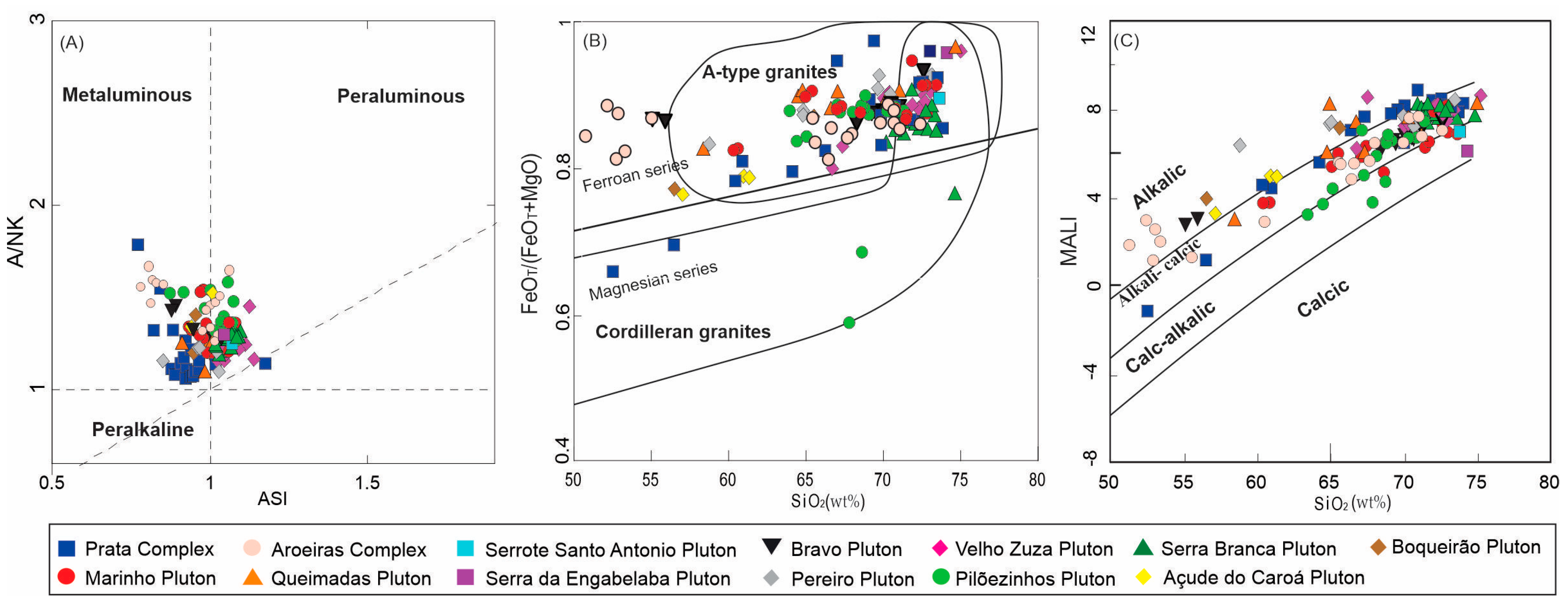





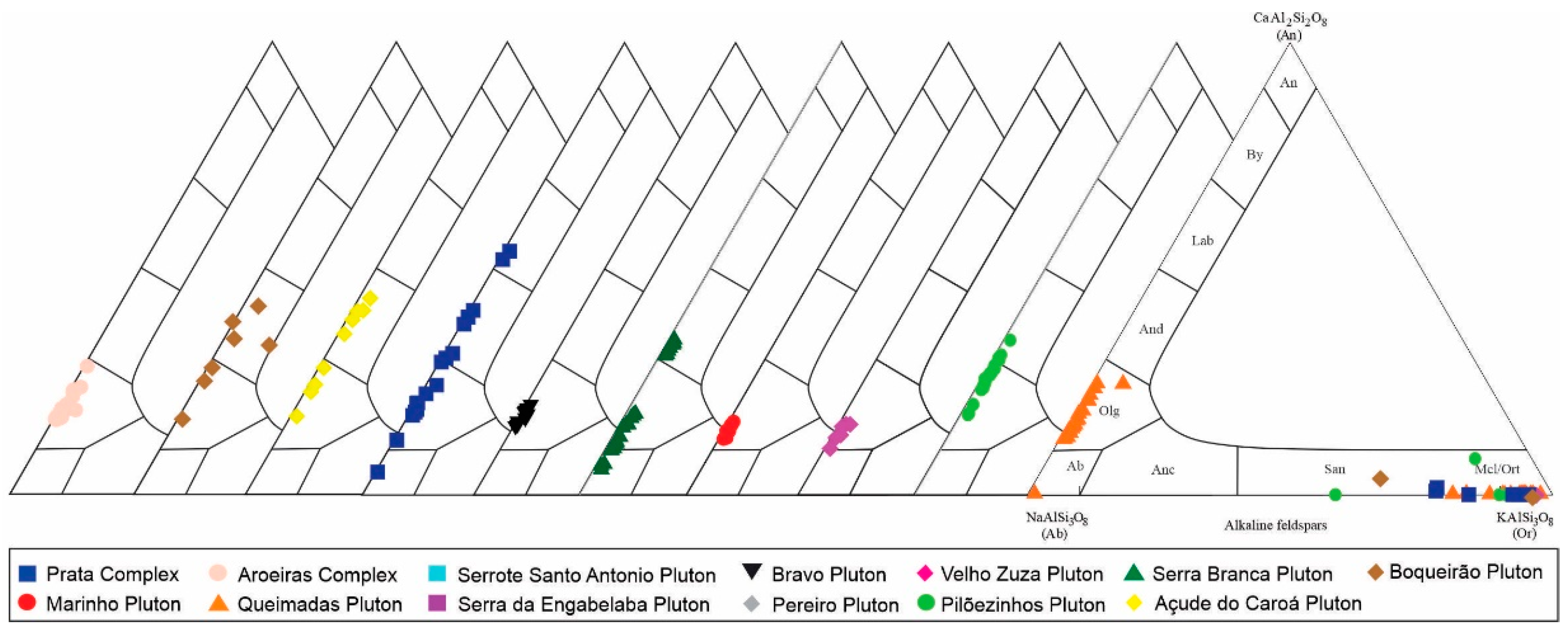
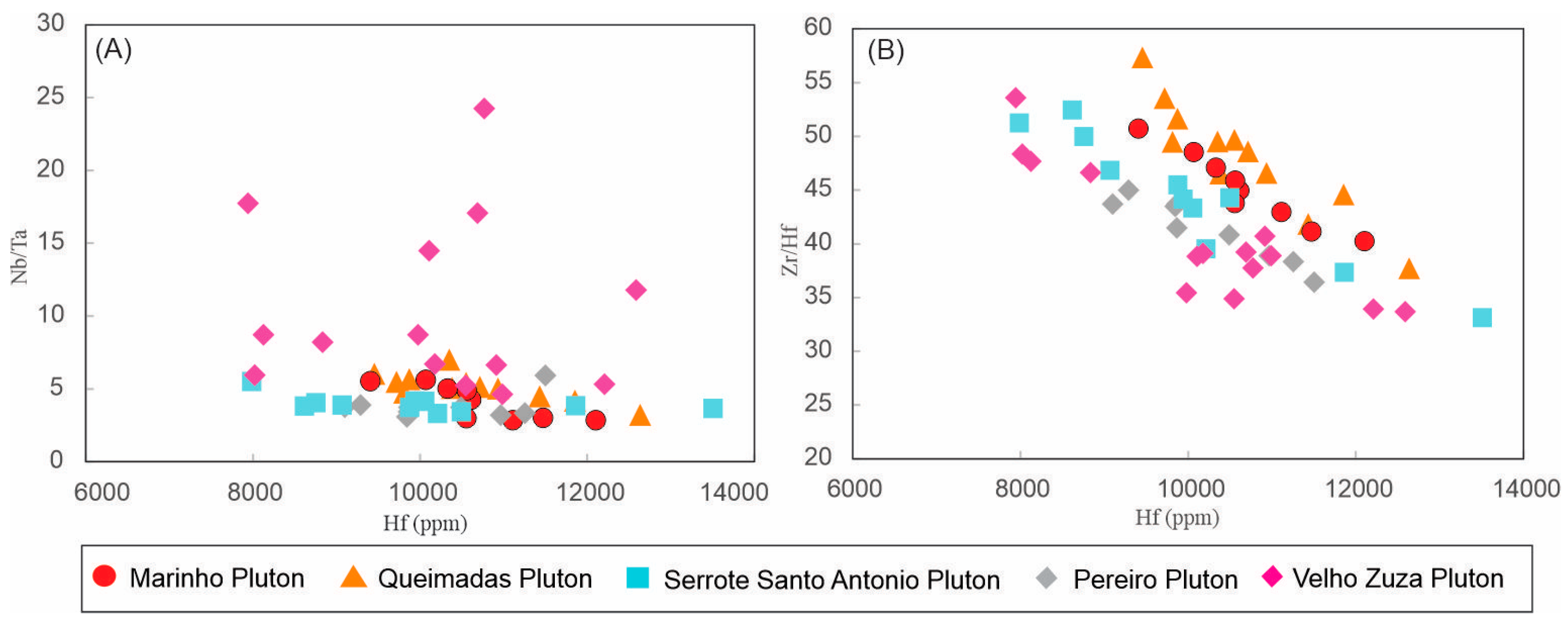
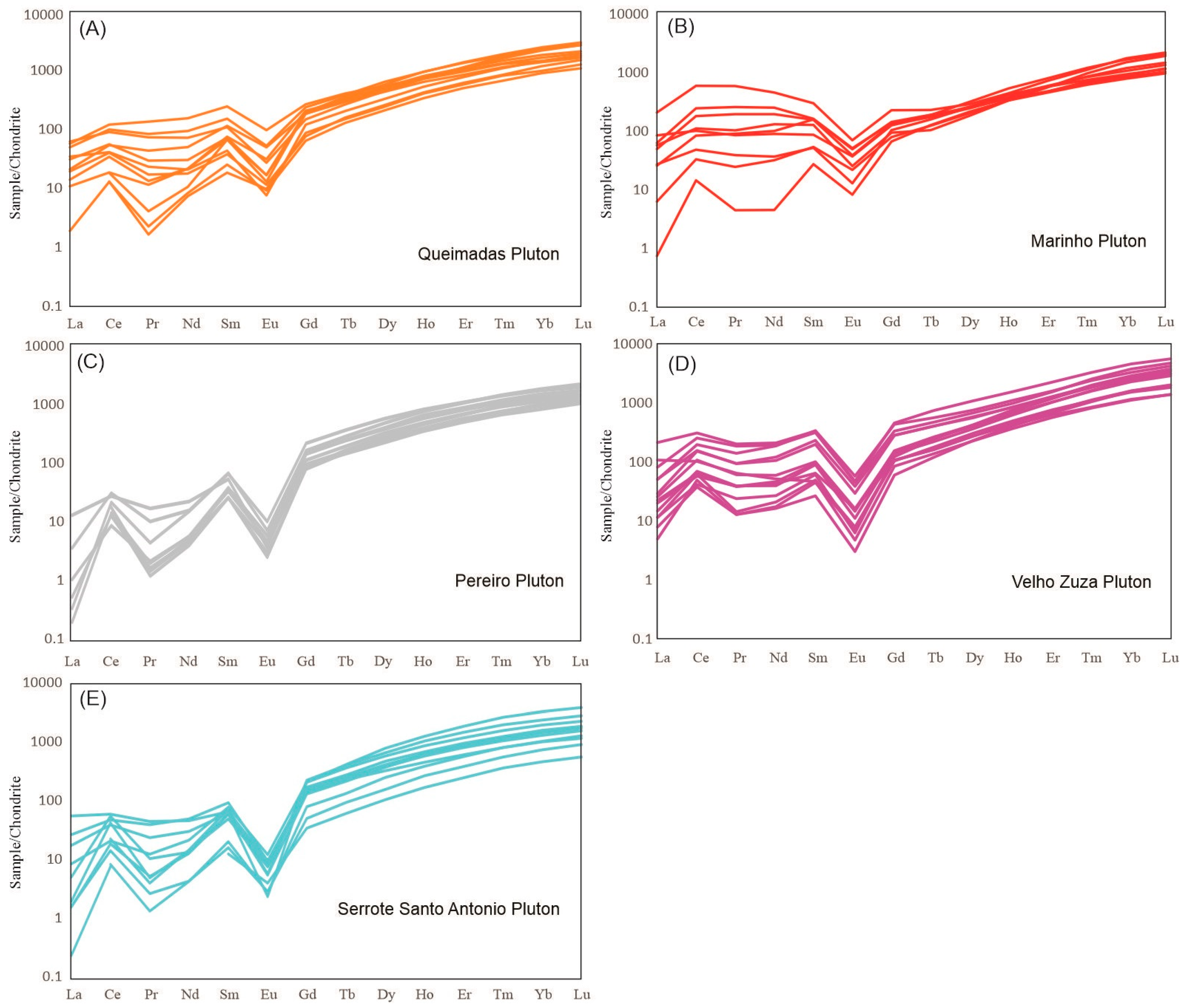
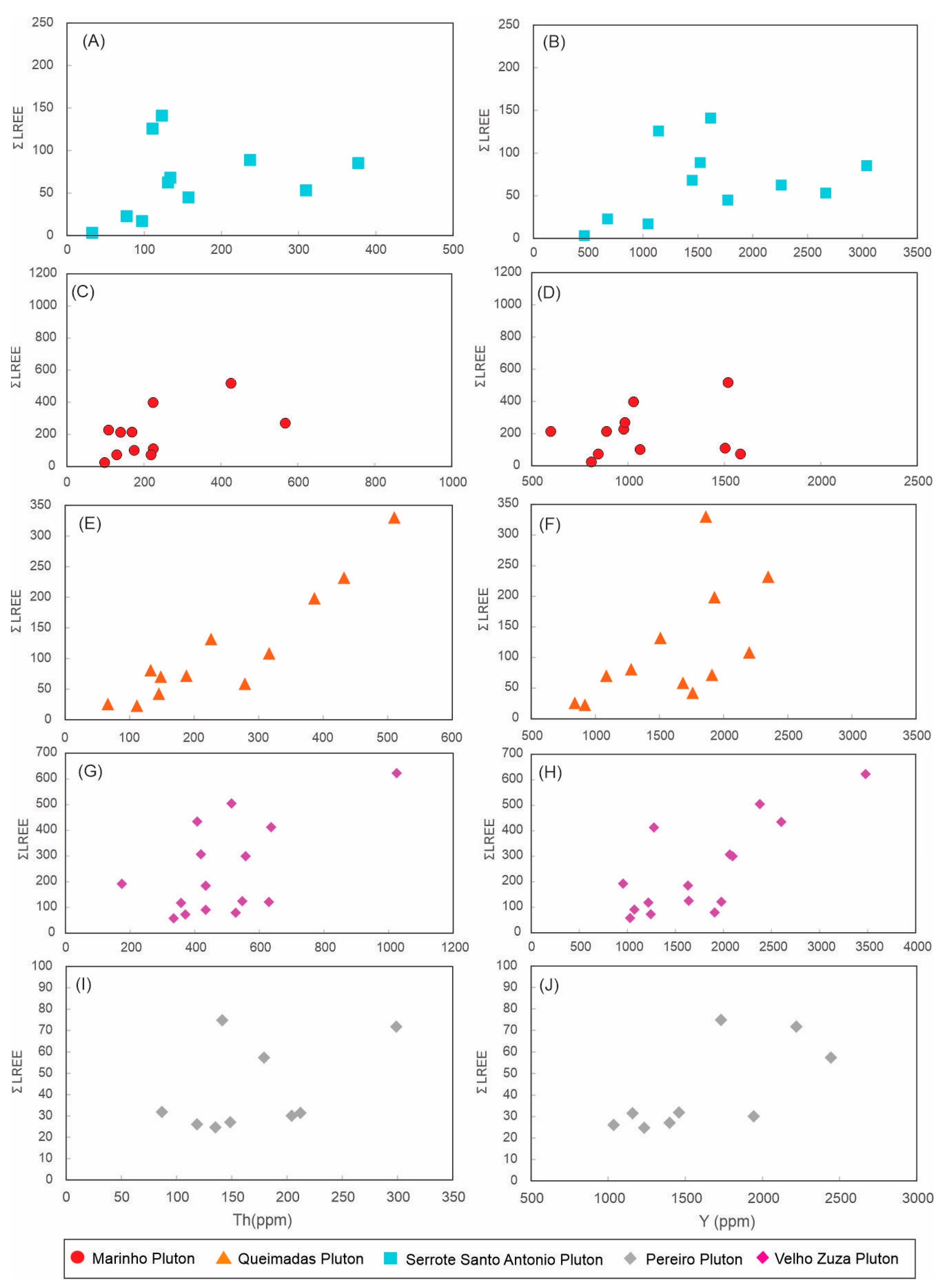
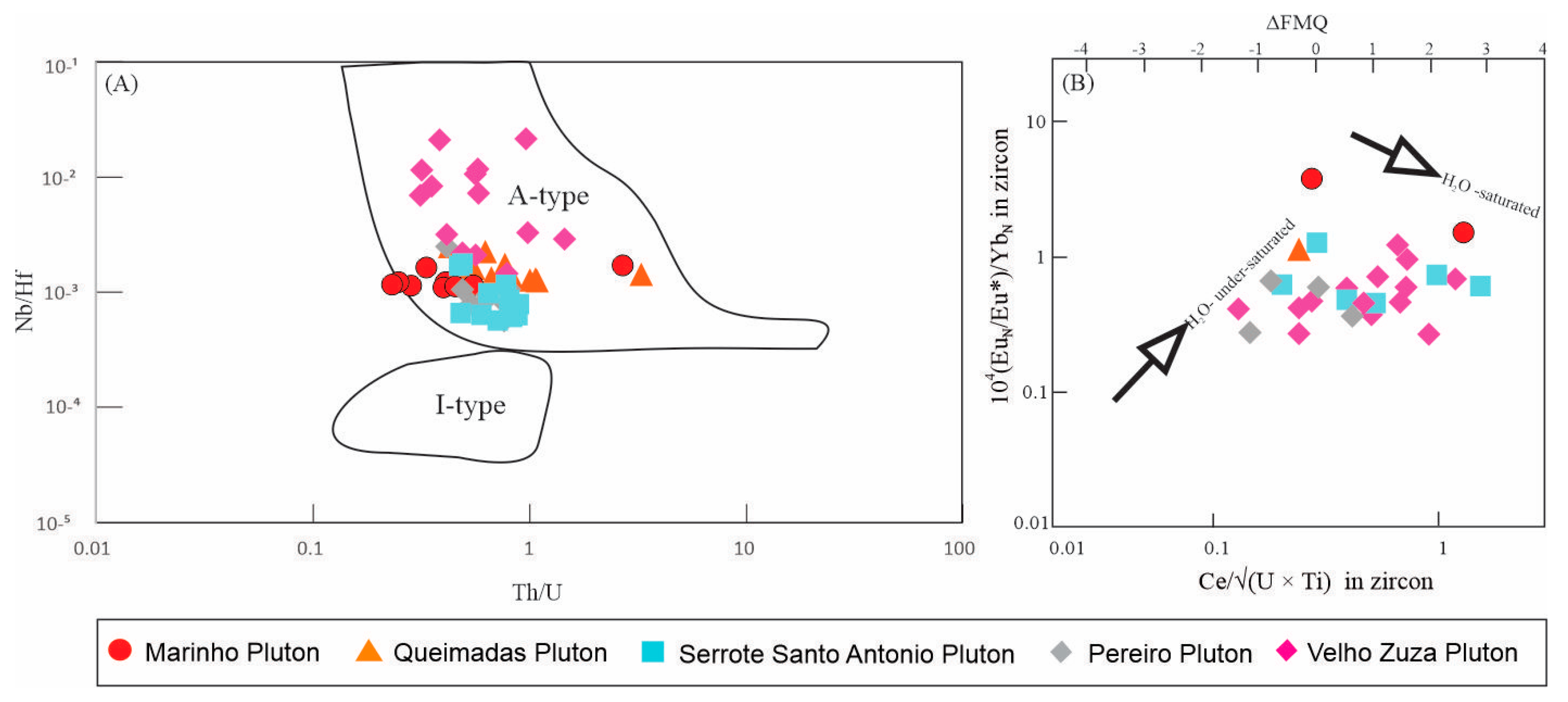
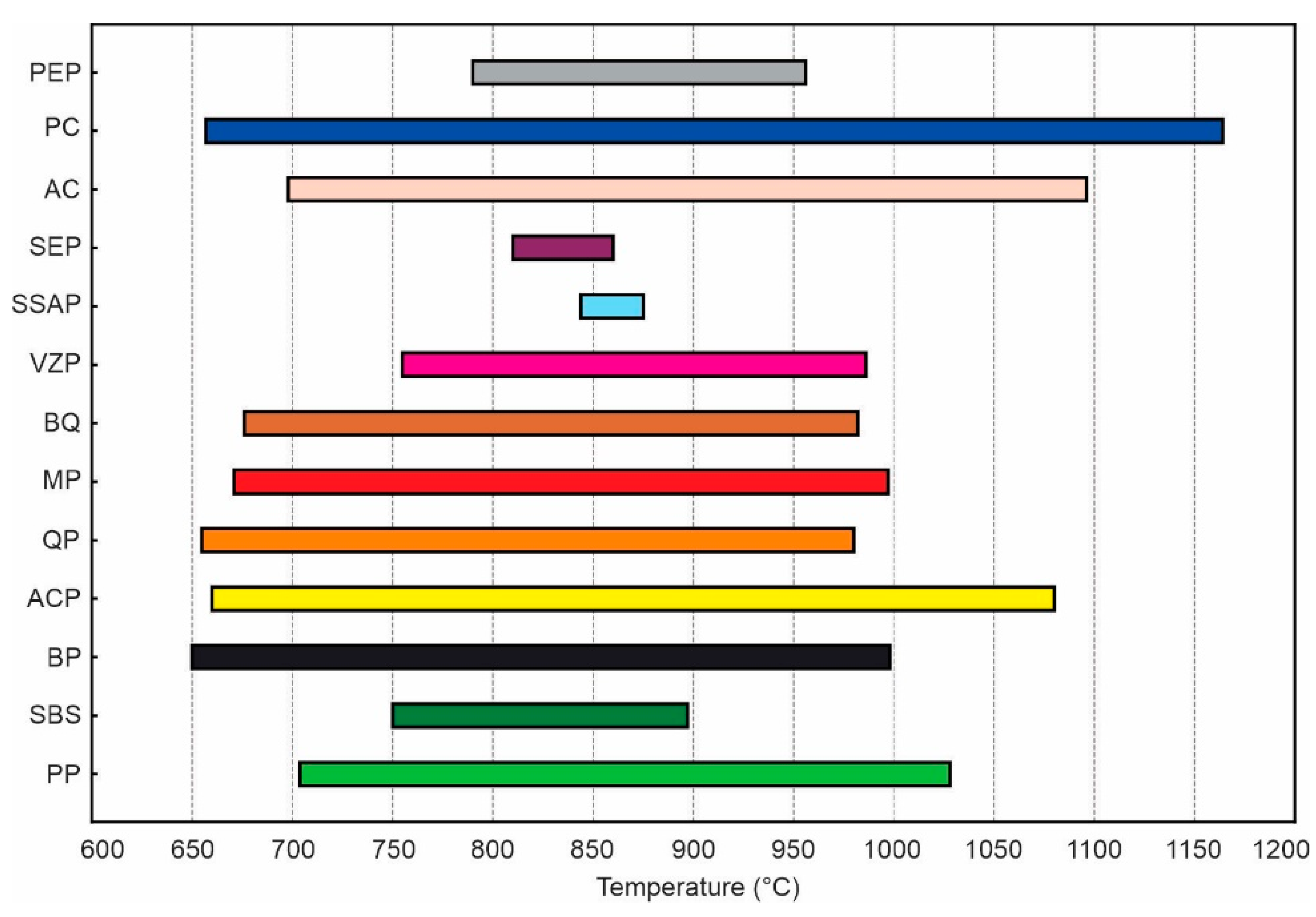
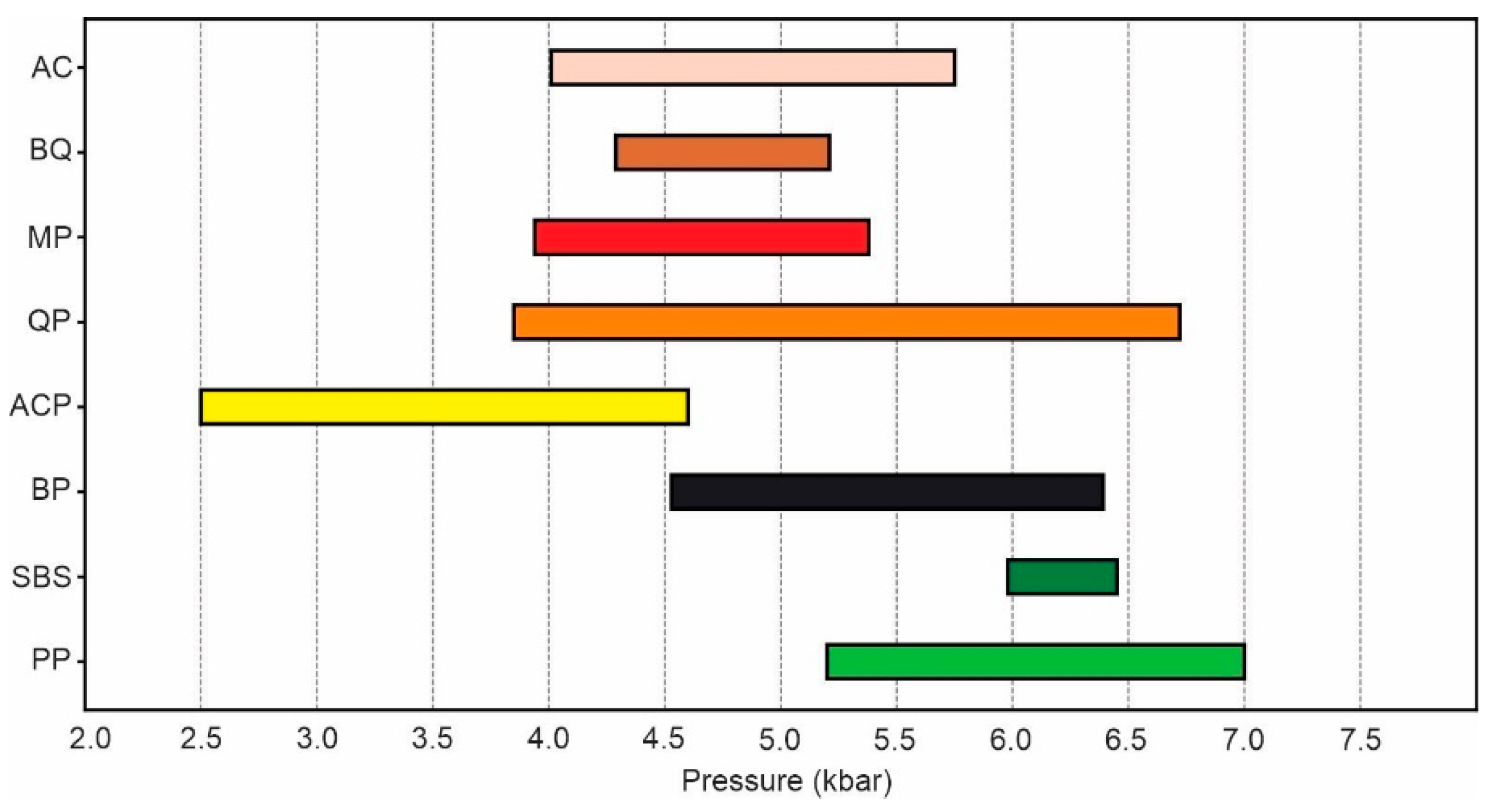

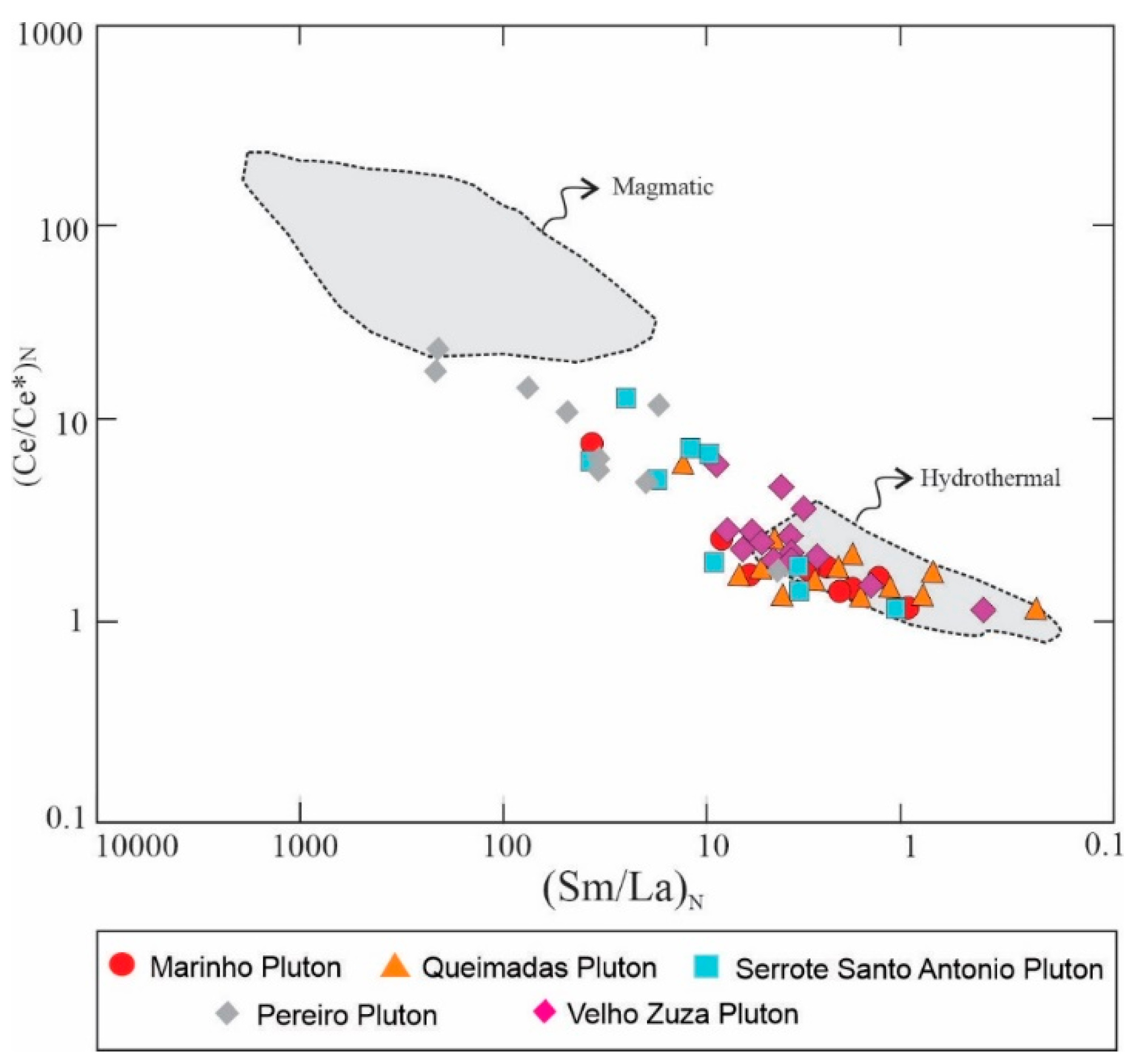
Disclaimer/Publisher’s Note: The statements, opinions and data contained in all publications are solely those of the individual author(s) and contributor(s) and not of MDPI and/or the editor(s). MDPI and/or the editor(s) disclaim responsibility for any injury to people or property resulting from any ideas, methods, instructions or products referred to in the content. |
© 2024 by the authors. Licensee MDPI, Basel, Switzerland. This article is an open access article distributed under the terms and conditions of the Creative Commons Attribution (CC BY) license (https://creativecommons.org/licenses/by/4.0/).
Share and Cite
de Lima, J.V.; Guimarães, I.d.P.; de Amorim, J.V.A.; Brainer, C.C.G.; dos Santos, L.; da Silva Filho, A.F. A Review of the Mineral Chemistry and Crystallization Conditions of Ediacaran–Cambrian A-Type Granites in the Central Subprovince of the Borborema Province, Northeastern Brazil. Minerals 2024, 14, 1022. https://doi.org/10.3390/min14101022
de Lima JV, Guimarães IdP, de Amorim JVA, Brainer CCG, dos Santos L, da Silva Filho AF. A Review of the Mineral Chemistry and Crystallization Conditions of Ediacaran–Cambrian A-Type Granites in the Central Subprovince of the Borborema Province, Northeastern Brazil. Minerals. 2024; 14(10):1022. https://doi.org/10.3390/min14101022
Chicago/Turabian Stylede Lima, Jefferson Valdemiro, Ignez de Pinho Guimarães, José Victor Antunes de Amorim, Caio Cezar Garnier Brainer, Lucilene dos Santos, and Adejardo Francisco da Silva Filho. 2024. "A Review of the Mineral Chemistry and Crystallization Conditions of Ediacaran–Cambrian A-Type Granites in the Central Subprovince of the Borborema Province, Northeastern Brazil" Minerals 14, no. 10: 1022. https://doi.org/10.3390/min14101022
APA Stylede Lima, J. V., Guimarães, I. d. P., de Amorim, J. V. A., Brainer, C. C. G., dos Santos, L., & da Silva Filho, A. F. (2024). A Review of the Mineral Chemistry and Crystallization Conditions of Ediacaran–Cambrian A-Type Granites in the Central Subprovince of the Borborema Province, Northeastern Brazil. Minerals, 14(10), 1022. https://doi.org/10.3390/min14101022






